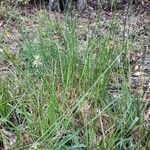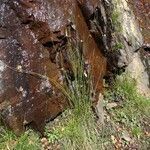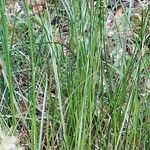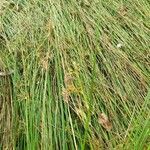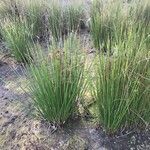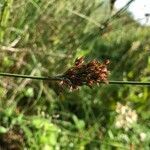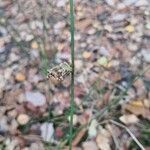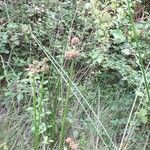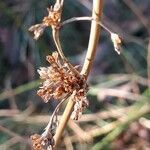Erect, quite glabrous perennial herb, 0.40-1.20 m high, with a horizontal, rather short, creeping, very short-jointed sympodial rhizome. Stems tufted, terete, in the living plant not or hardly ribbed, in dried specimens with very close-set faint longitudinal ribs; pith continuous. Basal sheaths closely embracing the stem, dull light-or darkbrown, obtuse, the inner often crowned by a deciduous awn. Not-flowering stems leafless (not computing the basal sheaths). Cymes pseudolateral, solitary, sessile, mostly 1½-5 cm long, rarely longer (up to 10 cm), dense or lax, usually many-flowered; bract of the inflorescence continuous with the stem and resembling it, very acute, 5-20 cm long. Flowers partly sessile, partly stalked, stalks up to 8 mm long. Floral bracts 2, very close together, ovate, thin, nerveless, ± ¾ mm long. Tepals narrowly ovate-lanceolate, very acute, firm with transparent thin margins, subequal, 2-2¾ mm long, pale green or yellowish. Stamens 3, much shorter than the tepals, rarely 4-6; filaments thin, short; anthers comparatively large, linear. Style very short; stigmas long, erect, filiform. Capsule oblong, trigonous, with a round or truncate (in Malaysian specimens not impressed) apex, brown, 2½-2¾ mm long, 3-valved; placentas rather deeply intruded. Seeds numerous, oblong, not tailed, ± ½ mm long, very faintly reticulate-ribbed.
Densely cespitose; stems to 1+ m, smooth or with 30–60 very low, inconspicuous ridges, the epidermal cells over the ridges not enlarged; basal sheaths to 2 dm, bladeless, mostly reddish-brown; invol lf (10–)15–25(–35) cm, appearing like a continuation of the stem; infl apparently lateral, many-fld, usually open, the longest branches (3–)4–10 cm; fls prophyllate; tep 2–2.5(–3) mm, stramineous, broadly lanceolate, acute, the outer commonly a bit longer than the inner; anthers 3; fr trilocular, slightly shorter to slightly longer than the tep, mostly obtuse to truncate, seldom J. griscomi) mucronate; 2n=40, 42. Open marshes and wet meadows; nearly cosmop., and throughout our range. Our common native plant, throughout e. U.S. and se. Can., is var. solutus Fernald & Wiegand, with rigid tep closely investing the fr. The European var. effusus, with soft tep ± spreading from the base, is locally intr. from Nf. to Me. and inland to Mich. and Minn. (Var. compactus, a form with compact infl)
Plants perennial, densely tufted. Rhizome shortly creeping, thick. Stems terete, 25--90 cm or taller × 1--3(--4) mm, striate; pith continuous. Cataphylls closely embracing stem, reddish brown to chestnut brown, sheathlike, 2--22 cm. Inflorescences pseudolateral, densely to laxly many flowered; involucral bract erect, seemingly a continuation of stem, terete, 5--28 cm. Perianth segments usually pale brown, linear-lanceolate, 2--2.7 × ca. 0.8 mm, unequal with outer ones slightly longer than inner, apex acute. Stamens 3(or 6), ca. 2/3 as long as perianth; anthers 0.5--0.7 mm, slightly shorter than filaments. Ovary 3-loculed. Style very short. Capsule ovoid to oblong, slightly depressed or not, subequaling or slightly longer than perianth, 3-septate, apex obtuse. Seeds ovoid-oblong, 0.5--0.6 mm, reticulate. Fl. Apr--Jul, fr. May--Sep. 2 n = 40, 42.
Perennials, tufted, up to 1 m tall, variable. Rhizomes horizontal, matted; roots many, fairly thick. Leaves basal, cauliform. Stems naked, erect, terete, 2-3 mm in diam., smooth, bright green, pith asterisciform, continuous; cataphylls 70-170 mm long, sheathing stems and leaves. Inflorescence pseudo-lateral, subtending leaf forming continuation of stem; flowers very numerous and very small, in globose to lax, decompound anthelae; bracts 3 per flower, small, hyaline. Tepals acute, c. 2-3 mm long, green, subsimilar. Stamens 3 (rarely 6); filaments about as long as anthers. Ovary obtuse; style 0; stigmas short. Capsule ovoid to rounded, refuse, membranous, pale yellowish; seeds 0.4 mm long, fusiform but bulging on one side, golden brown, reticulate with strong wavy lines, becoming mucilaginous when wet. Flowering in spring and summer.
Densely tufted, perennial, rhizomatous herb. Leaves on linear horizontal rhizomes, 1-few per shoot, hard, terete, rush-like. Scape terete, pith continuous. Inflorescence pseudolateral, ± one-fifth from top of scape, with one subtending bract forming a continuation of scape, and two bracteoles. Flowers abundant in much-branched panicles (anthelae), congested when young and lax when mature. Perianth segments lanceolate, finely pointed, 2-3 mm long, subequal. Stamens 3(6), filaments ± as long as anthers. Ovary with 3 ± separate locules; ovules biseriate, many; style short, with 3 short stigmatic arms. Capsule loculicidal, 3-valved, broadly ovoid. Seeds many, ± 3 mm long.
Herbs, perennial, 4--13 dm. Rhizomes short-branched, forming distinct, often large clumps. Culms erect, terete, 1--2.5 mm diam. at top of sheaths. Cataphylls several. Leaves: blade absent. Inflorescences lateral, compound dichasia, many flowered; primary bract erect, terete, extending well beyond dichasium. Flowers: tepals tan or darker, usually with greenish midstripe, lanceolate, 1.9--3.5 mm; inner slightly shorter; stamens 3, filaments 0.5--0.8 mm, anthers 0.5--0.8 mm; style 0.2 mm. Capsules greenish tan or darker, 3-locular, broadly ellipsoid to oblate, 1.5--3.2 mm. Seeds amber, (0.3--)0.4---0.5 mm. 2n = 40, 42.
Tufted, perennial herb, up to 1 m high. Leaves surrounded below by sheathing cataphylls, 70-170 mm long; blade cylindric, cauliform; pith in leaves and scapes continuous, at least in lower part. Flowers: inflorescence placed ± one-fifth from top of straight scape; scape bright to yellowish green, smooth with 40-90 longitudinal stripes; each flower with a bract and 2 bracteoles; tepals 2 mm long, spreading; stamens 3; perianth green; Nov.-Jan. Fruit obtuse, thin.
Dense tufts; rhizome short. Stems 30-120 cm × 1.5-3 mm, soft and easily split or compressed, bright-or yellow-green, smooth, shining, pith continuous, cobwebby. Basal sheaths reddish-brown closely appressed to stem. Inflorescence many-flowered, base of subtending floral bract narrow, green. Tepals 2-2.5 mm long, ± equal, acuminate. Stamens3. Capsule 2-2. long, < or occasionally = tepals, ovoid, flattened at top, very light brown.
Tufted, perennial herb, up to 1 m high; stems with continuous pith. Leaves cylindric, cauliform, surrounded below by sheathing cataphylls, 70-170 mm long. Tepals 2 mm long, spreading. Stamens 3. Capsule obtuse, thin. Flowers green.
A rush which forms tufts or clumps. The stems are rigid and smooth but twisted. It has green spikes up to 1 m tall. It spreads 75 cm wide. The leaves are soft tipped and most leaves are near the base. The flower spikes are brown.
Tufted perennial to 1 m. Leaves cylindrical, stem-like. Flowers in tight pseudolateral clusters, green.
